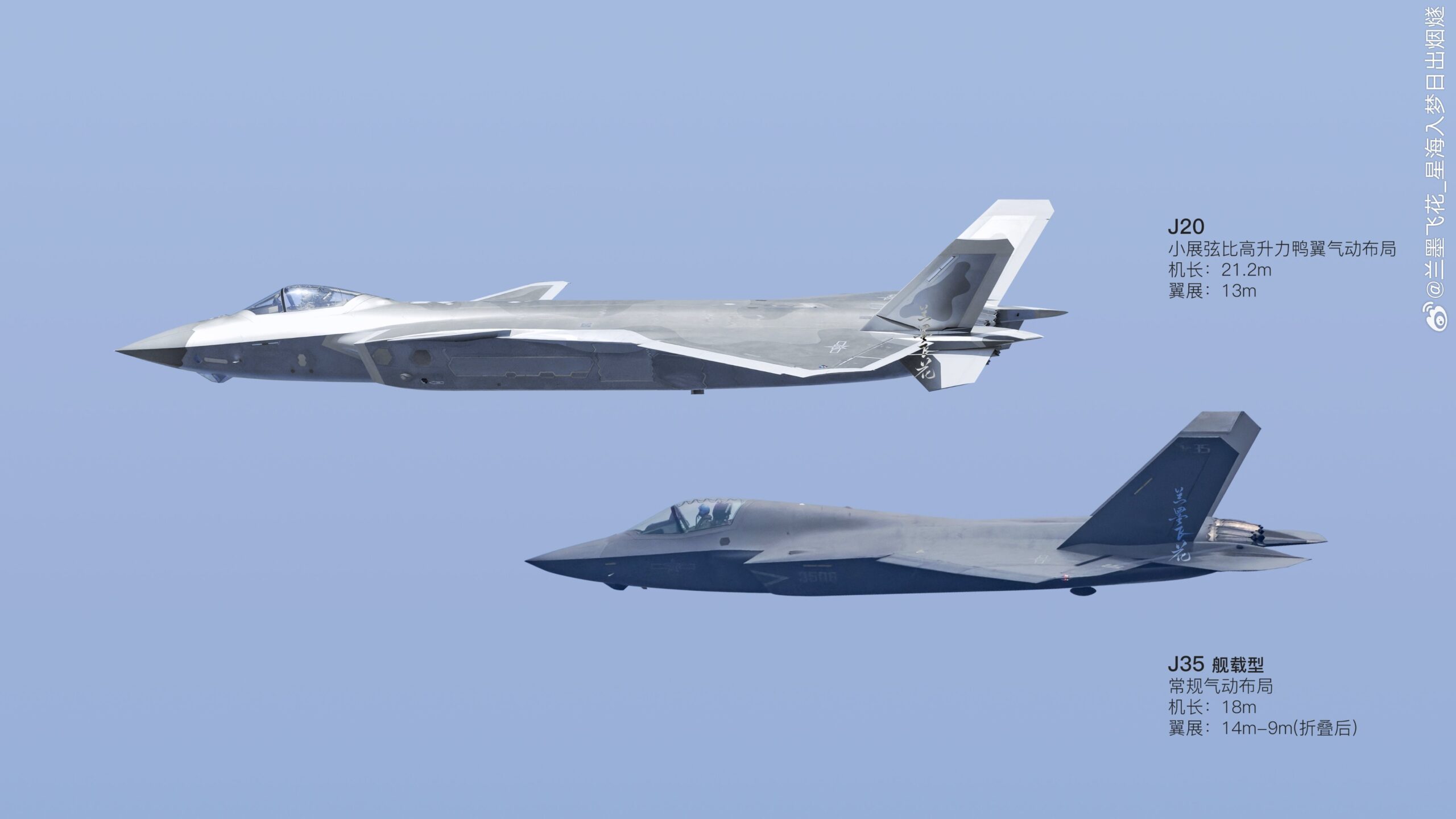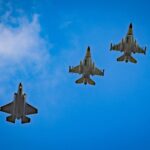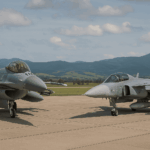Fresh air-to-air photos released on Chinese and foreign social media within the last forty-eight hours show two J-35 prototypes – serials 3501 and 3506 – in razor-sharp clarity. The images answer long-standing questions about the fighter’s finish, engines, and deck-handling features, while offering new clues on production status.
New Chinese Fighter Jet J-35 Stealth Fighter Nears Production Freeze
The lead jet, 3501, still carries its detachable pitot boom, a tell-tale sign that flight-test instrumentation remains on board. Its wingman, 3506, wears a sealed radome and a clean nose profile. Defense officials confirm the difference marks a split between instrumented test assets and near-series examples. Both aircraft mount Luneburg lenses under the belly, making them easier to track on radar when stealth is not required.
Our analysis shows the outer skin keeps tight panel gaps and flush fasteners. Even removable doors sit almost level with adjoining surfaces. That points to improved tooling at Shenyang’s production line. Light catches along the chine reveal a continuous, almost polished contour from the nose to the inlets. According to industry sources, these refinements came after early drag surveys identified weak spots in laminar flow.
J-35 Stealth Fighter Powerplant and Deck-Handling Enhancements Indicate Naval Focus
A close crop of 3506’s tail exposes twin serrated exhaust petals. The saw-tooth edges disrupt radar reflections and cut infrared bloom. Slight discoloration around the nozzle roots hints at extended high-cycle thermal runs during envelope expansion.
Powerplant data remain limited, yet program insiders say both jets still rely on uprated WS-13E engines. Ground test reports released this month show the higher-thrust WS-19 reached full afterburner for the first time, clearing a key gateway toward flight trials. Once installed, the WS-19 should raise thrust-to-weight above 1.1 on a clean loadout, giving the fighter healthier catapult margins.
Ground shots posted yesterday reveal the folding-wing hinge. The joint sits mid-span, protected by a slim fairing. A hydraulic jack nestles inside the fold line. Deck crews gain space below when wings pivot upward, while the swept-up tailplane eases elevator clearance on the hangar deck. The nose gear shows a reinforced launch bar and a beefier strut than earlier FC-31 demonstrators.
The key external changes visible in the new imagery:
- Sealed radome on 3506 with no test probe
- Revised electro-optical window under the port intake
- Sharper chine alignment into the canopy sills
- Flush dorsal blade antenna for satellite datalink
- Strengthened arresting-hook mount aft of the engines
None of these details appeared with equal precision in previous leaks. Each signals that design freeze is close.
A separate photo set shows both aircraft taxiing past a weapons-loading stand. Trial shapes next to 3506 include a long-range PL-15E air-to-air missile and two low-drag glide bombs. According to industry sources, engineers ran stores-interface checks but held live-fire work for a later phase. The mounting rails appear complete, and wiring harnesses route cleanly into the weapons bay.
Deck-handling clips shot from a chase helicopter add fresh data. The jets performed thirty-degree banks, shallow climbs, and a single touch-and-go on a runway painted with carrier landing lines. Energy bleed looked well-controlled; touchdown plume length stayed short. Flight-control laws handled the bolter rehearsal without visible pilot corrections. Defense officials confirm envelope-expansion goals for June have been met. J-35 appear in joint flight with carrier operations, reinforcing their naval integration.
Movement on the carrier side is just as brisk. Satellite photos taken on 19 June show deck markings aboard the Type 003 Fujian that match the J-35’s wheelbase. The carrier concluded its sixth sea trial period this week, and planners intend a captive-carry taxi test before summer ends.
Inside the cockpit, the canopy bond line now runs smooth and continuous. Reflectivity dropped in the latest finish, hinting at a thinner indium-tin-oxide layer for electromagnetic shielding. Reflections show a single panoramic display that spans most of the instrument panel. Pilots get a wider field of view than legacy J-15 crews, and touch controls replace many hard switches.
Landing-gear upgrades stand out. The main bogie shifts to a two-wheel truck, raising arrested-recovery weight limits. Wheel hubs show extra tie-bolt rows, and the oleo struts carry longer stroke chambers. Other platforms like the Z-20 helicopter have also adopted such evolutionary upgrades for naval deployment. Those changes suggest heavier avionics packs or an enlarged environmental-control system.
Production Progress and Export Prospects for China’s J-35 Naval Fighter
Production pacing is clearer now. Commercial imaging last week counted six airframes on Shenyang’s final-assembly floor – four in primer, two in low-visibility gray. Assembly jigs line up with folded wings, confirming a naval focus. Our analysis shows that low-rate initial production could start before year-end if current throughput holds.
Export momentum is growing in parallel. Pakistan signed for forty land-based FC-31A derivatives, with deliveries scheduled from late 2025 through 2028. Training packages include full-motion simulators and a data-link gateway that aligns with existing JF-17 infrastructure. Other potential buyers are watching. Saudi Arabia, Egypt, and the United Arab Emirates have expressed preliminary interest, drawn by lower unit cost and looser end-use strings than U.S. offerings.
Current export conversations:
- Pakistan – 40 FC-31A units under contract, first airframes by Q4 2025
- Saudi Arabia – exploratory talks; evaluating offsets and local assembly
- Egypt – request for proposal focused on anti-ship loadouts
- UAE – informal delegation met with AVIC at the Paris Air Show
The avionics backbone shows a modular spine with removable panels. Those tiles likely cover line-replaceable mission computers and threat-receiver racks. Crews can swap processors without deep airframe cuts, easing future upgrades. Designers learned from J-11 fleet overhauls that once required extensive structural work for minor electronics changes.
Data-link antennas now dot the upper fuselage and wing roots. A flush aperture under the starboard intake probably hosts a Ku-band transceiver. The link lets a J-35 receive cueing from the new KJ-600 carrier airborne early-warning aircraft without emitting radar energy. China’s growing drone arsenal shows similar advances in network-centric operations. Fleet watchers say that connection will form the backbone of Chinese cooperative engagement doctrine at sea.
Deck-ops ergonomics also improved. The nose attitude stays level while taxiing, giving pilots better forward view. Directors can stand closer to the nosewheel without ducking under an intake lip. Chock points align with PLAN deck dollies, and tie-down rings match the spacing used on Liaoning and Shandong.
Strategic implications are immediate. A single Fujian air wing could field thirty-two J-35s plus four KJ-600s, keeping continuous combat air patrols while holding a quick-strike detachment alert. Two carriers operating together would double that presence, stretching far into the Western Pacific. Regional forces are already reacting. Japan accelerates F-35B deployment on its Izumo-class ships, and South Korea revisits a naval KF-21 variant. Australia’s latest defense review calls for expanded fighter rotations through Guam and acquisition of additional systems like AMRAAM missiles.
Engine development remains the biggest variable. Bench tests show the WS-19 meets thrust targets but still faces cyclic fatigue hurdles. Instrumented blades survived 1,500 cycles before micro-cracking started – short of the planned 2,000-cycle goal. Engineers next plan a core-engine flight on a J-11 testbed by December if durability work stays on track.
Upcoming milestones stack closely:
- July 2025 – captive-carry taxi run on Fujian
- September 2025 – first shipboard catapult launch
- November 2025 – arrested-landing trials with telemetry loads
- January 2026 – weapons-separation tests at Dingxin range
- June 2026 – full-envelope expansion to 50,000 ft and Mach 1.6
- Late 2026 – initial operating capability for the first PLAN squadron
Confidence in the program shows in the imagery release strategy. Twelve years ago, China’s stealth prototypes appeared only in fuzzy snaps. Today, state channels push near-HD photos of a nearly production-ready jet. That shift signals industrial maturity and serves as a quiet sales pitch to prospective buyers.
In less than two days, public understanding of the J-35 jumped from vague outline to tangible detail. Surface joints, hinge points, and even nozzle welds now sit under the global microscope. Defense officials confirm the project remains on budget and on schedule. As more uncensored images emerge, the fighter edges closer to routine deck cycles – no longer a concept, but an impending fixture of PLAN aviation.
REFERENCE SOURCES
- https://x.com/sugar_wsnbn/status/1934957074079011004
- https://asiatimes.com/2025/06/chinas-j-35a-courting-buyers-barred-from-us-f-35s/
- https://www.airdatanews.com/chinese-naval-fighters-j-35-appear-in-joint-flight/
- https://www.twz.com/air/chinas-j-35-naval-stealth-fighter-seen-like-never-before
- https://economictimes.indiatimes.com/news/defence/pakistan-to-get-40-more-j-35-stealth-jets-soon-what-are-its-capabilities-and-should-india-be-concerned/articleshow/121981722.cms
- https://www.scmp.com/news/china/military/article/3314946/social-media-videos-pla-jet-rehearsals-heighten-buzz-over-chinas-victory-day-parade
- https://x.com/jonescrasto/status/1936278063907561770
- https://x.com/Alfa_Particle/status/1935500269745487971
- https://x.com/RupprechtDeino/status/1935703535124967488
- https://x.com/EurasiaNaval/status/1935250104505540770
- https://x.com/Nickatgreat1220/status/1936016707405201885
- https://x.com/chaoyinsukandao/status/1935974158808367214
- https://x.com/RupprechtDeino/status/1936095768961855904


